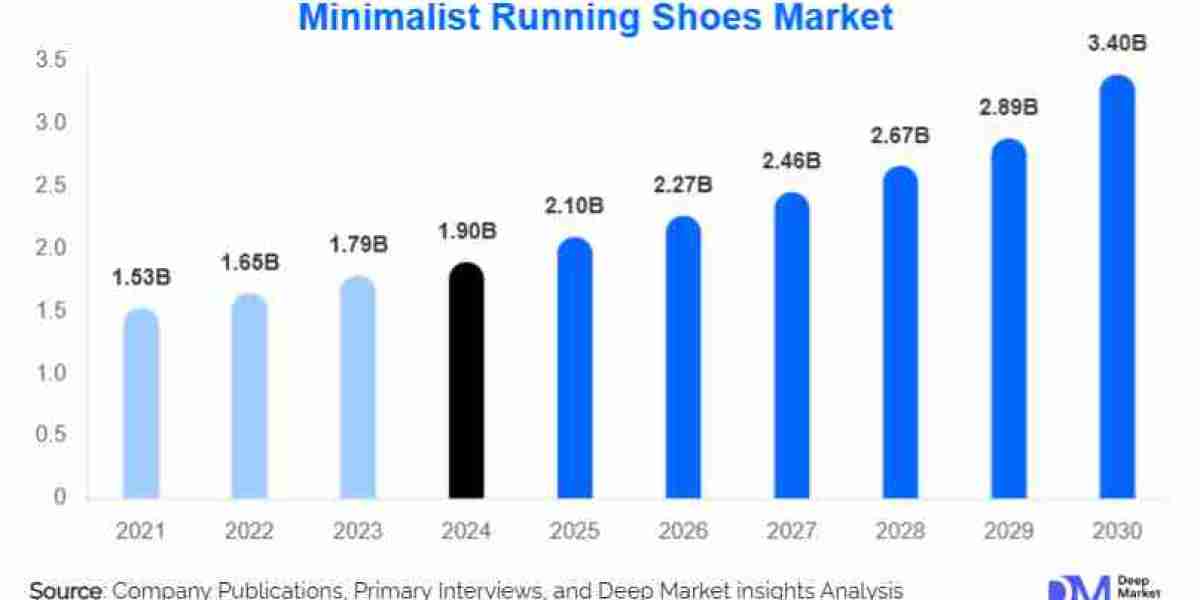According to Deep Market Insights, the global minimalist running shoes market was valued at USD 1.9 billion in 2024 and is set to expand from USD 2.1 billion in 2025 to USD 3.4 billion by 2030, registering a compound annual growth rate (CAGR) of 8.3% during the forecast period. The growth reflects the rising adoption of barefoot-style running, heightened awareness of natural gait efficiency, and consumer preference for lightweight footwear that promotes strength and injury prevention.
Key Insights
Product Design: Toe-box wide designs dominate, reflecting consumer demand for natural foot splay, balance, and improved stability.
Regional Leadership: North America remains the largest market, while Asia-Pacific is the fastest-growing region, supported by increasing fitness participation and barefoot running communities.
Expanding Subcategories: Barefoot trail shoes and minimalist trainers designed for gym use are driving diversification.
Sales Channels: E-commerce and direct-to-consumer platforms lead distribution, supported by digital education on injury prevention and natural running techniques.
Market Size and Forecast
2024: USD 1.9 billion
2025: USD 2.1 billion
2030: USD 3.4 billion
CAGR (2025–2030): 8.3%
North America: Largest market
Asia-Pacific: Fastest-growing region
Emerging Trends
Ultra-minimalist recovery footwear: New sandals and slip-ons with barefoot geometry extend minimalist applications into post-run recovery.
Hybrid barefoot-trail models: Low-stack designs with protective but flexible outsoles cater to runners seeking natural ground feel on rugged terrain.
Strength-training integration: Minimalist trainers are gaining traction in gym settings, supporting crossover between performance running and conditioning.
Market Drivers
Natural movement philosophy: Increased focus on foot strength, proprioception, and balance drives adoption in both running and lifestyle categories.
Cross-training demand: Minimalist footwear is expanding beyond running into gym-based functional training.
Digital education: Online tutorials, gait workshops, and running clubs support consumer confidence and accelerate uptake.
Market Restraints
Injury adaptation risk: Transitioning too quickly from cushioned shoes to minimalist designs may cause calf or metatarsal injuries.
Limited athlete endorsements: Lack of sponsorships compared to cushioned or carbon-plated shoes reduces mainstream exposure.
Durability perception: Lightweight builds and thinner midsoles raise concerns over longevity and premium pricing.
Market Opportunities
Smart barefoot footwear: Integration of sensors and gait-tracking technology opens opportunities for data-driven training solutions.
Lifestyle crossover: Barefoot-style casual and work shoes align with wellness trends, expanding reach beyond athletics.
Children’s footwear: Pediatric models designed around natural foot development remain an untapped growth segment.
Segmental Insights
By Type: Barefoot road shoes dominate; barefoot trail models and gym-specific trainers are fast-growing.
By End-User: Male runners lead usage, but women’s and youth models are gaining share due to targeted designs.
By Distribution Channel: Online platforms and brand-owned stores dominate, with specialty retailers supporting education-driven adoption.
Regional Highlights
North America: Largest market, supported by strong fitness culture and established retailers.
Europe: Adoption led by Germany, the UK, and Scandinavia, supported by outdoor sports and natural movement advocacy.
Asia-Pacific: Fastest growth, with rising barefoot events in Japan, China, and India, supported by government-led fitness initiatives.
Latin America: Growth in Brazil and Mexico supported by e-commerce expansion and community-driven fitness programs.
Middle East & Africa: The UAE and South Africa are emerging markets, with growth supported by wellness tourism and boutique fitness brands.
Leading Companies
The competitive landscape includes established brands and niche innovators:
Vibram S.p.A.
Merrell (Wolverine World Wide Inc.)
Vivobarefoot
Xero Shoes
New Balance Athletics Inc.
Inov-8
Lems Shoes
Altra Running (VF Corporation)
Topo Athletic
Skora Running
Recent Developments
February 2025: Vibram expanded its FiveFingers line with bio-based rubber minimalist trainers.
April 2025: Vivobarefoot launched a children’s barefoot footwear range targeting natural foot development.
June 2025: Xero Shoes introduced a hybrid barefoot-trail shoe for both ultra-distance running and strength training.
Conclusion
The global minimalist running shoes market is entering a high-growth phase, fueled by consumer demand for natural movement, cross-training adaptability, and lifestyle integration. With Asia-Pacific driving the fastest expansion and digital channels reinforcing adoption, the sector is set to exceed USD 3.4 billion by 2030.
About Us
Deep Market Insights is a leading market research organization, specializing in research, analytics, and advisory services along with providing business insights & market research reports
Contact Us:
Website: https://deepmarketinsights.com/







